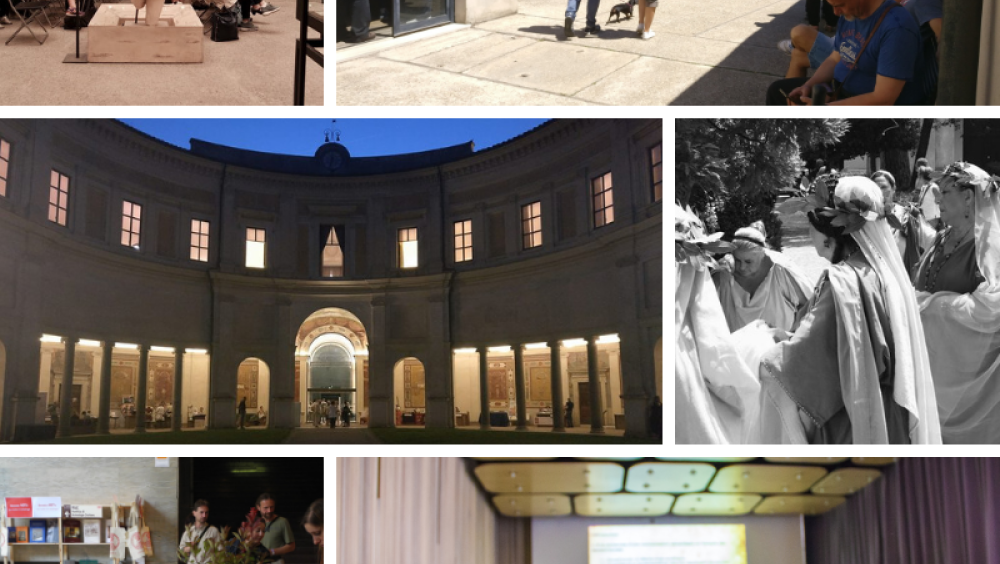RomArchè. Parla l'archeologia
Vue d'ensemble
Our cultural project "RomArché. Parla l’archeologia" - which, as evoked in the name, has been held in Rome every year since 2010 hosted by a different museum - in ten years of life has had at its core the enhancement of the European archaeological heritage through the promotion of specialized publishing houses and through international scientific conferences that have given rise to constructive collaborations between scholars. In particular the conferences deal with archaeological, anthropological and museological themes and are paired with a small Publishing Fair that illustrates the themes of the edition to the heterogeneous public (not only scholars but also passionate adults and children) with their own publications. In the days of Romarché the host museum institution comes alive with initiatives aimed at involving people in a fascinating journey back in time also facilitated by many other enhancement activities ranging from historical re-enactment, to concerts of ancient music, to guided tours of the museum, educational workshops, experimental archeology, in a general desire to include all types of public which is also at the core of the project.
“Romarché. Parla l’archeologia "has been designed, from the beginning, to meet the need for a new cultural communication in the archaeological field. What we wanted to achieve was the involvement of a wider audience in cultural activities: not only scholars and professionals of the cutural sector but also enthusiasts, children, the inquiring minds, all our heritage community (as defined by the Faro Convention). Our goal was to bring people (and possibly bring them back several times) to museums, involving them intellectually, emotionally and also, why not, having fun, finally creating relationships and contacts in order to make everyone feel ownership on their cultural heritage. In this regard, in the ninth edition of RomArché, held at the National Etruscan Museum of Villa Giulia in 2018, which was awarded with the European Heritage Label, we wanted to talk about "creative networks" as part of our multi-year conference project "museum.dià "(where every other year we bring together European specialists to discuss topics of museological interest). Nowadays museums organizes itself and acts in a deeply developed system of interconnections and it is easy to notice that the technological revolution underway has changed the relationships between museum institution, public, territorial context as well as the ability to generate contents and understandable languages.
The networks have thus become places of creation of content and new models, bringing museum professionals to dialogue and confront each other like never before.
Lastly a big part of RomArché is aimed at bringing new and recurring visitors back to the museum with initiatives crafted to involve them both intellectually and emotionally, thanks to performances of historical re-enactment (dances, concerts), thematic guided tours, conferences, projection of documentaries, evening opening of the museum, fun activities for children including animated readings and educational workshops. All in the presence of specialized publishers who, with stands set up in the Museum's Hemicycle, went out of their way to illustrate their publications (treatises, novels, comics, guides) to an increasingly curious public. The result was a riot of sounds and colors that once again invested the National Etruscan Museum of Villa Giulia, home of Romarché for three editions, which not only welcomed the project but actively collaborated so that our aims were realized giving rise to a beautiful example - in our opinion - of public-private collaboration.
European Dimension
“Romarché. Parla l’archeologia "feeds on the principles of the aforementioned" Framework Convention of the Council of Europe on the value of cultural heritage for society "(Faro Convention 2005), which introduced in Article 2 an expression that has become for us fundamental to describe our target audience, namely that of heritage communities: “an inheritance community is made up of a group of people who attach value to specific aspects of cultural heritage, and who, within the framework of public action, support them and pass them on to future generations”. In particular, points a) and b) of art. 1 of the Convention constitute the prerequisites of our project: a. recognize that the right to cultural heritage is inherent in the right to participate in cultural life, as defined in the Universal Declaration of Human Rights; b. recognize an individual and collective responsibility towards cultural heritage. And finally RomArché strongly recognizes the "role of cultural heritage in building a peaceful and democratic society, in sustainable development processes and in promoting cultural diversity"; hoping and trying to facilitate with our cultural initiatives "a greater synergy of skills between all the public, institutional and private actors involved" (point d. of art. 1).
